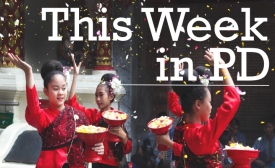india
Prime Minister Narendra Modi on Saturday termed terrorism and climate change as the biggest problems faced by the world saying the solutions to these can be found in Mahatma Gandhi's life and ideals. [...] Modi also expressed hope that people of Turkmenistan will learn about the ideals and life of Mahatma Gandhi.
The Indian Embassy in Cairo has hosted its annual ‘Iftar’ party to mark the holy month of Ramadan. The party on Wednesday was attended by a large number of Egyptian ministers, politicians, diplomats, intellectuals and well-known artists as well as ambassadors of other countries.
As one of its new initiatives, the Indian Council for Cultural Relations (ICCR), the cultural diplomacy wing of the Ministry of External Affairs, is organising an International Conference about Princess Suriratna of Ayodhya, who is believed to have married a Korean King.
“When Indian Prime Minister Narendra Modi congratulated Chinese Premier Li Keqiang on his 60th birthday on his Sina Weibo account on Wednesday (July 1), he once again showed the high value he attaches to diplomacy through social media accounts,” the Global Times stated.

PD News takes a look at what China, the UK, India and the U.S. have been up to this week.
UN's decision to commemorate the International Day of Yoga underlines the appreciation for India and its growing soft power, External Affairs Minister Sushma Swaraj has said.
Swaraj, who addressed the first International Day of Yoga celebrations at the UN, also attended a function marking the day at the Hindu Temple Society of North America yesterday.
The way the day was commemorated around the globe, "the world had made the first International Day of Yoga its own," Swaraj said at the Hindu Temple Society of North America.
The impressive participation around the world on International Yoga Day is indeed a testimony to India’s immense reservoir of soft power. In his energetic engagement with world leaders, Prime Minister Narendra Modi has put a special emphasis on cultural diplomacy. Modi should, however, remember that India’s soft power has the greatest impact when official New Delhi keeps its heavy hand away from it. India is not new to cultural diplomacy. India’s self-discovery of its rich cultural heritage and its global reach played an important role in shaping its modern nationalism.
The more significant question to ask is whether it serves as an important tool for India’s aspirations as a global power. Many have written that yoga is one of the best “soft power” tools in India’s global tool kit. In the US alone, it claims to be a heavy-duty industry worth more than $30 billion. Most people who practice yoga know that it emerged in India almost 5,000 years ago, and recognise its holistic attributes. So, how will this grand-scale exercise enhance India’s global image?







